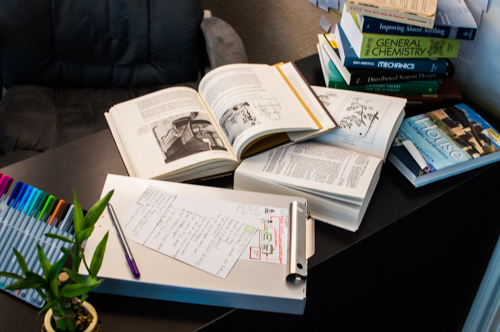LearnAnythingFast



Study Lessand Learn More



Use the Feynman Technique to make the learning process more effective.
If you sit and try to memorize the facts about a complex subject like the theory of general relativity, you might think that such concepts are better left to the Einsteins of our world. But memorization doesn’t lead to understanding. It helps you remember terminology, names and dates. Comprehension comes when you know how it works and not just what it’s called. So, how do you come to understand a difficult concept? You teach it.
The Feynman Technique is a self-learning strategy for picking up new information quickly. Based on the learning style of famed physicist Richard Feynman. His methods give you a real world application to learning.
“I learned very early the difference between knowing the name of something and knowing something.” - Richard Feynman
Richard Feynman never published a step by step process for this learning strategy. It is more a less a tribute to him and his drive to understand things. Through reading and hearing stories of Feynman and his pursuit of knowledge, students and admirers of his have been able to piece together his technique into a workable strategy that anyone can do. The most relevant example is from the story "A Different Set of Tools” from the book Surely You're Joking, Mr. Feynman!
In this story, Feynman was surprised by the way his peers in the mathematics department couldn’t speak about their subject in simple terms. They’re explanations were full of jargon and complicated language that even they were having trouble wrapping their heads around the material. Feynman stepped in to challenge them to explain their theories in a straightforward language and even he (unfamiliar with mathematical theories) would be able to reach the proper conclusion of true or false.
In this process, four things take place.
Learn.
Begin with a specific concept or a question you want answered. Find some research material and study until you feel you have an adequate understanding of the answers.
Teach it.
Try to explain your concept, from memory. Imagine you’re writing to yourself before you did your research. What didn’t you know then that you know now? What did you want to know?
Fill in the Gaps.
From your explanation, you may notice gaps in your understanding. Find the places where you’re still unsure and go back to the books to clarify.
Find Analogies.
Once a concept becomes known to you, it can mingle with the rest of your mind. Try to fit it into the things you already understand to make analogies. During this process, simplify your words so that you don’t include any terminology. Relate it to your world so that anyone can understand it as you have.
With Feynman, the mathematicians wanted to explain their theories in the language they were taught. But Feynman was adamant that doing so overcomplicated things; made things appear more difficult than they really are. So he urged them to simplify it enough in plain language so that he could understand without having to add to his own vocabulary. Not only did this help Feynman learn, but it also helped the mathematicians gain a better understanding. It’s a win-win scenario.
The beauty of this process is that to learn, you must share. The learning process requires open discussion and questioning our current understanding of things. When you are driven to find answers, pursuing them becomes a way of life.
To read the story from Richard Feynman and many other of his tales of learning, pick up a copy of his book on Amazon. You will be simultaneously entertained and inspired!
Be a life learner... and a life teacher.
- Incorporate new concepts into your understanding of the world.
- Know the things you learn well enough to teach them.
█







